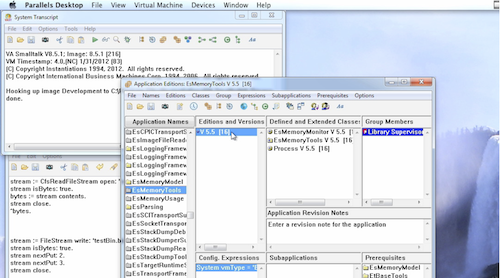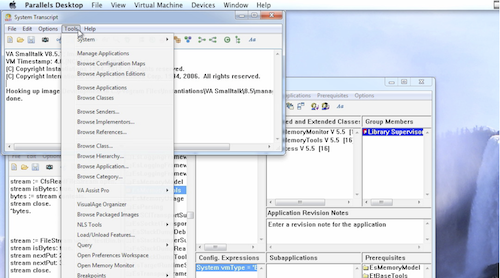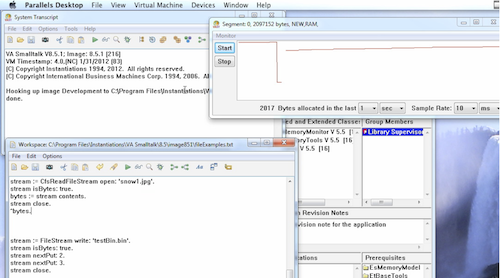BioSmalltalk: New Release
A new version of BioSmalltalk has been released. BioSmalltalk is the Smalltalk environment for doing bioinformatics with Pharo. There's a list of features, status and to do's at the link
Tags: pharo
The author of this blog, James Robertson, passed away in April 2014. This blog is being maintained by David Buck (david@simberon.com).
A new version of BioSmalltalk has been released. BioSmalltalk is the Smalltalk environment for doing bioinformatics with Pharo. There's a list of features, status and to do's at the link
Tags: pharo
Well, this is a cheery sounding bit of news:
Today Robert Templeman at the Naval Surface Warfare Center in Crane, Indiana, and a few pals at Indiana University reveal an entirely new class of ‘visual malware’ capable of recording and reconstructing a user’s environment in 3D. This then allows the theft of virtual objects such as financial information, data on computer screens and identity-related information.
You download a camera app, but it's actually this thing. Awesome.
Today's Smalltalk 4 You looks at loading applications into ObjectStudio. The way things end up being displayed for use (and where the Transcript is located) differs somewhat from VisualWorks and VA Smalltalk.. If you have trouble viewing it here in the browser, you can also navigate directly to YouTube. To watch now, click on the image below:
If you have trouble viewing that directly, you can click here to download the video directly. If you need the video in a Windows Media format, then download that here.
You can also watch it on YouTube:
Tags: smalltalk, objectstudio
Enclosures:
[st4u326-iPhone.m4v ( Size: 3392373 )]
I ran across this yesterday - I have a second monitor attached to my Mac, and I use Parallels (Win 7) to play games that aren't out for Mac. I set the big screen to be the primary, fired off Parallels, and then started XCOM: Enemy Unknown. And... the mouse pointer is registering dozens of pixels off. To hit a button, I have to move the mouse way to the right. If I play in mirrored mode (less resolution), everything works fine. No other game does this too me - I'm wondering whether it's a Parallels artifact, or something else?
It's not the concept of patent law that I object to; it's where things have gotten to. Unless we adopt "loser pays", there's really no way out of the crap sandwich world we now live in. No patents would - absurd as that sounds - be better than what we have now.
Tags: patents

|
Today's Javascript 4 You looks at using 3rd party libraries in the maps api. If you have trouble viewing it here in the browser, you can also navigate directly to YouTube. Join the Facebook Group to discuss the tutorials. You can view the archives here. |
To watch now, click on the image below:
If you have trouble viewing that directly, you can click here to download the video directly. If you need the video in a Windows Media format, then download that here.
You can also watch it on YouTube:
Enclosures:
[js4u233-iPhone.m4v ( Size: 2467642 )]
This change happened back in 7.8, but since we are only now upgrading, we ran into it while going from 7.6 to 7.9.1. Take code that looks like this in VW 7.6:
point := 4@-5.
In 7.6, that gives you a point object. In newer VW? It gives you the message #@- sent to 4 with an argument of 5. Same thing with fractions. Not hard to fix - just look for senders of #@- and #/- and then use a rewrite rule to fix them. Better yet, it was turned up by our unit test suite :)
Tags: visualworks, upgrade
Today's Smalltalk 4 You starts looking at the basic memory monitoring tools available in VA Smalltalk. If you have trouble viewing it here in the browser, you can also navigate directly to YouTube. To watch now, click on the image below:
If you have trouble viewing that directly, you can click here to download the video directly. If you need the video in a Windows Media format, then download that here.
You can also watch it on YouTube:
It can be useful to get an idea as to how memory is being used as parts of your Smalltalk application are running - VA Smalltalk provides some tools that allow you to have that look. First off, you'll need to load some applications using the ApplicationManager (EsMemoryTools)

Once that's loaded, go to the launcher's tools menu, and start the monitor:

If you start it, not a lot will be happening - after all, we aren't really running anything but the base image. Try something - here, we loaded an image file using streams:

See the changes? You can use this to better effect when running your application (or hotspots in it) to see what's going on.
Need more help? There's a screencast for other topics like this which you may want to watch. Questions? Try the "Chat with James" Google gadget over in the sidebar.
Enclosures:
[st4u327-iPhone.m4v ( Size: 2375511 )]
Welcome to episode 109 of Independent Misinterpretations - a Smalltalk and dynamic language oriented podcast with James Robertson and David Buck.
This week Dave and I talked about Collections, and how important it can be to pick the right one. As an example, Dave explains a recent consulting assignment where using the right collections in one method shaved execution time from 23 minutes to 21 seconds..
You can subscribe to the podcast in iTunes (or any other podcatching software) using this feed directly or in iTunes with this one.
To listen now, you can either download the mp3 edition, or the AAC edition. The AAC edition comes with chapter markers. You can subscribe to either edition of the podcast directly in iTunes; just search for Smalltalk and look in the Podcast results. You can subscribe to the mp3 edition directly using this feed, or the AAC edition using this feed using any podcatching software. You can also download the podcast in ogg format.
If you like the music we use, please visit Josh Woodward's site. We use the song Troublemaker for our intro/outro music. I'm sure he'd appreciate your support!
If you have feedback, send it to jarober@gmail.com - or visit us on Facebook - you can subscribe in iTunes using this iTunes enabled feed.. If you enjoy the podcast, pass the word - we would love to have more people hear about Smalltalk!
Tags: smalltalk, collections
Enclosures:
[im109.mp3 ( Size: 11538175 )]
Welcome to episode 109 of Independent Misinterpretations - a Smalltalk and dynamic language oriented podcast with James Robertson and David Buck.
This week Dave and I talked about Collections, and how important it can be to pick the right one. As an example, Dave explains a recent consulting assignment where using the right collections in one method shaved execution time from 23 minutes to 21 seconds..
You can subscribe to the podcast in iTunes (or any other podcatching software) using this feed directly or in iTunes with this one.
To listen now, you can either download the mp3 edition, or the AAC edition. The AAC edition comes with chapter markers. You can subscribe to either edition of the podcast directly in iTunes; just search for Smalltalk and look in the Podcast results. You can subscribe to the mp3 edition directly using this feed, or the AAC edition using this feed using any podcatching software. You can also download the podcast in ogg format.
If you like the music we use, please visit Josh Woodward's site. We use the song Troublemaker for our intro/outro music. I'm sure he'd appreciate your support!
If you have feedback, send it to jarober@gmail.com - or visit us on Facebook - you can subscribe in iTunes using this iTunes enabled feed.. If you enjoy the podcast, pass the word - we would love to have more people hear about Smalltalk!
Tags: smalltalk, collections
Enclosures:
[im109.m4a ( Size: 15,849,658 )]